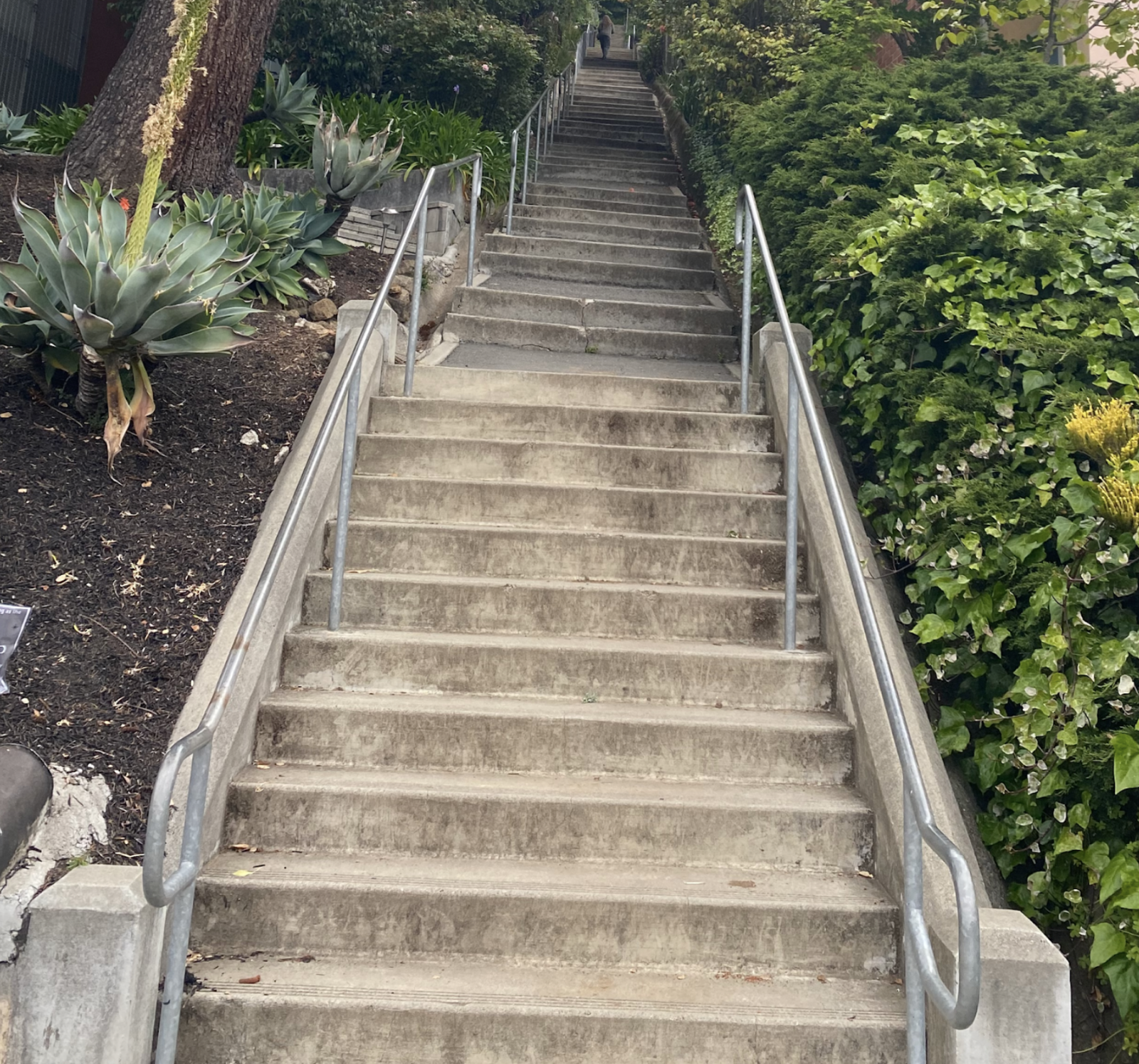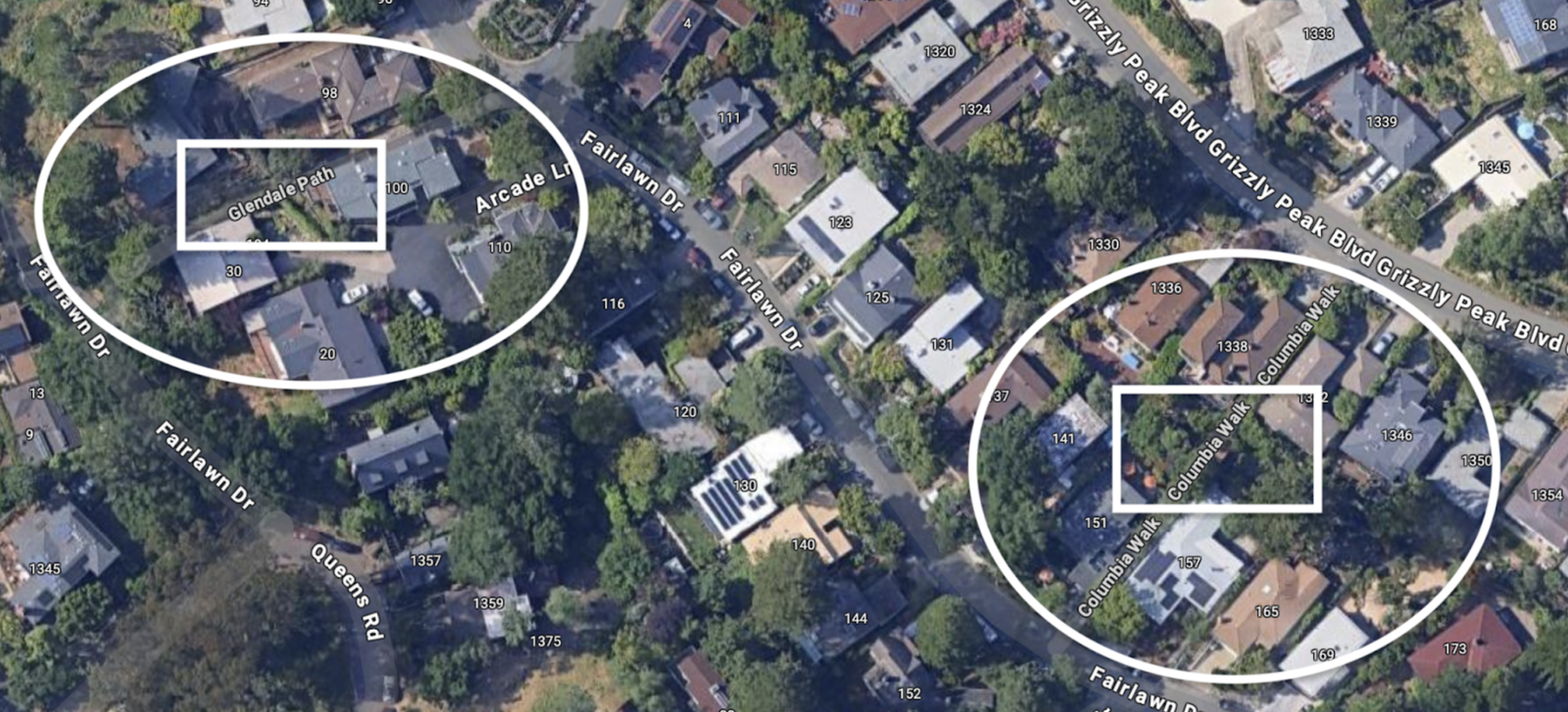Fire risk’s unrecognized impacts on home values in hilly areas


· 9 min read
When urban areas in the U.S. were initially designed over 100 years ago, pedestrian sidewalks and stairways were important components because they fostered pedestrian and public transit. Once automobiles became widely used, many were no longer as useful as they once had been.
In recent years, as stakeholders changed their views of urban areas, sidewalks and stairways acquired new roles.
In this article, I will outline how the benefits of urban pedestrian sidewalks and stairways have evolved, the impacts on property values, and the implications for stakeholders in urban hilly areas at risk of fires.
Starting in the 19th century, sidewalks became common parts of the urban landscape in the U.S. primarily because they provided safe and clean walking places separate from horse-drawn vehicles. As automobiles gained broad adoption, many people became dependent on them and pedestrianism declined.
Over the last four decades this trend has largely reversed. Many urban areas’ populations significantly grew, driven by intertwined factors including:
1) employment opportunities
2) government policies
3) desires to easily access urban amenities and
4) walkability
The values of many urban residential properties have become correlated to their proximity by foot to commercial areas and transit. According to the Urban Land Institute, residential unit values increase by $700 to $3,000 for every point increase to the Walk Score, a proxy for walkability that rates proximity to commercial destinations on a scale of one to 100 points. Values of residential units located walking distance from a transit station have approximately a 40% premium on property value.
Commercial property values have also benefited from walkability. An increase of 10 points in the Walk Score was associated with an increase of 5 to 8 percent in commercial values.
Increasing value attached to walkability shows how old inventions like sidewalks can revive or have new impacts on the built environment.
Many hilly urban developments that were finished before the broad adoption of automobiles included networks of stairs for pedestrians that could facilitate daily mobility. For example, in Pittsburgh, stairs provided steelworkers with ways to walk to and from their hillside homes and steel mills. In the Oakland and Berkeley (“Oakland/Berkeley”), California hills, pedestrian stairs were incorporated into residential developments around the turn of the 20th century with the primary purpose of connecting residents to streetcar stops.
Today, many of Pittsburgh’s stairways (a total of 800) are used for commutes, exercise, and exploration. In the Oakland/Berkeley, California hills, the wide adoption of the automobile largely eliminated stairways’ transit purposes, leaving them mostly for use during exploration and exercise.
In one part of the hills, stairways played a new role in October 1991. Due to hot and windy weather, dry flora conditions, and low firefighting water supply from fire-induced electricity outages at reservoir water pumps, a small fire in the area spread across 1,600 acres, destroying 3,469 houses and apartment units and killing 25 people.
In a small but strategically important area, firefighters used the 139-step Eucalyptus Path to haul water hoses whose water helped save the homes along the Eucalyptus Path and nearby Sunset Trail:


Source: author
While other factors may have played a role in saving homes along and near the Eucalyptus Path, such as slowing wind speeds, falling temperatures, and improving availability of water from fire hydrants, the presence of the path played a role. The stairways not only provided routes for fire-preventing water hoses, but they also served as means for residents to escape fires without navigating circuitous narrow roads crowded with escapees driving automobiles and rescuers driving fire trucks and other vehicles.
Many residents, firefighters, and governments may not have been aware of the possibility of such a strong and sizable fire nor the value of these stairways (though it is important to recognize that stairways in other areas did not save homes.) This was the fifteenth recorded fire in the Oakland/Berkeley, California hills since 1923 but by far the most destructive. Between 1923, when the first Oakland/Berkeley hills fire was recorded, and 1990, fourteen major fires were recorded in the Oakland/Berkeley hIlls under similar weather environments at a maximum of every 10 years: Homes were destroyed in seven of those fires:
• Five fires destroyed an average of 4.2 homes
• Two of the seven were large fires:
• One in 1923 that destroyed 584 homes and
• One in 1970 (21 years before the above described 1991 fires) that destroyed 37 homes
Improved stairways in North Berkeley, California hills in response to Oakland and Berkeley, California hills:
In the aftermath of the fire, stakeholders tangibly recognized the value of such stairways in a different part of the Oakland/Berkeley hills.
When the Berkeley Hills were developed approximately 100 years ago, 136 rights-of-way paths were deeded to the city by developers for stairways that could create shortcuts down steep hillsides to public transit. However, about 50 of the paths were not completed. Following the Oakland/Berkeley hills fire, federal, state, and local governments recognized the importance of minimizing the risk of fires and their effects on neighborhoods. Funding was disbursed to manage vegetation, clear unused paths, and upgrade existing paths. Two affected stairways in the Berkeley Hills are shown below:

Because stairways can reduce the privacy of adjacent homes, the value of some such homes might be negatively affected. Yet, as the risk of fire increases or neighborhoods are rebuilt following fires, could values of homes located immediately adjacent to stairways see a boost due to a combination of the following?:
1) the safety provided for residents from fire
2) the accessibility provided for firefighters trying to save a home and
3) corresponding lower insurance rates
It isn’t clear to me from First Street’s Wildfire Model Technical Methodology whether they take into account how stairways might protect homes from fire. Whether they do or not, not all stakeholders may presently recognize how stairways can impact home value. In the future, might some insurance companies change policies for homes adjacent to stairways and/or might buyers and sellers adjust the value they attach to such homes?
Stakeholders have been increasing their use of traditional tools and employing new tools to prevent future wildfires and be prepared to react should they start. Some examples include:
Traditional tools
Controlled fires: After beginning to gain traction in the U.S. in the beginning of the 20th century, their use has accelerated in recent years. Between 2017 and 2019, there were more than 800,000 controlled fires in the U.S., up from 44,000 between 2007 and 2009.
Defensible spaces around buildings: Required in areas protected by CALFIRE since the 1960s (CALFIRE is a California state agency responsible for protecting natural resources from fire on land designated by the State Board of Forestry as State Responsibility Area), involuntary and voluntary creation of defensible spaces have grown in recent years.
Clearance and thinning of flammable materials located farther afield from buildings: These actions have increased though there is some debate about the efficacy of such practices in forests.
Use of fire resistant building materials in new and existing buildings: Their use goes back several centuries but in recent years technologically-advanced solutions have been gaining traction.
Coordinated fire hydrant fittings and water system upgrades: Both actions seek to avoid shortage of water needed for firefighters to fight future fires.
Community education about prevention and preparedness
Improved coordination between government agencies, organizations, and communities around wildfire prevention and responses
New Tools
Use of AI to identify recently ignited fires: Companies like Pano AI use AI to detect, verify, and classify wildfires.
Consolidation and dissemination of real-time intelligence about wildfires: Organizations like Watch Duty attempt to improve reactions to wildfires.
Reduction of fire threat from utilities’ assets: Efforts including better management of generation and transmission infrastructure, nearby vegetation, and distribution infrastructure.
These tools can reduce the risk of fire even as weather conditions become more severe. Again, all stakeholders may not be aware of all such tools nor the potential impact on a specific area and value.
Home values might adjust to reflect how stairways and various tools can mitigate fire risk. However, it is unlikely that all insurance companies, sellers/agents, and bidders/agents have become aware of all of these changes nor the impact on present and future values. Those who evaluate the relevance of a new impact on value, such as urban stairways, fire resistant building materials, or AI fire detection, and when/how they will be taken into account will be positioned to make valuable investments.
Take insurance behavior as a case in point. In California, despite state government mandates that insurers reward insurees who take steps to protect their homes from wildfires, many insurers have yet to do so. In the future, insurance companies might realize that by lowering insurance costs for such properties, they can maximize profit. Where a seller/agent and bidders/agents of a specific property do not realize that there could be a long-term premium, a bidder could benefit. For example, a seller that doesn’t recognize the value of the stairway, or the impending use of fire resistant building materials or AI fire detection might value their property at $1.5 million while a bidder that does recognize those factors realizes that there is a $300,000 premium to the listed price and can win the bid by bidding $1.6 million.
Fire risk is presenting new challenges for all stakeholders. By paying attention to how old inventions such as stairways and traditional fire resistant tools, and new inventions such as AI change fire risk, stakeholders may be in a position to value properties with more refinement than others.
illuminem Voices is a democratic space presenting the thoughts and opinions of leading Sustainability & Energy writers, their opinions do not necessarily represent those of illuminem.
illuminem briefings

Corporate Governance · Adaptation
illuminem briefings

Sustainable Finance · ESG
illuminem

Adaptation · Biodiversity
CBC News

Climate Change · Biodiversity
Human Rights Watch

Adaptation · Environmental Rights
The Wall Street Journal

Public Governance · Sustainable Finance